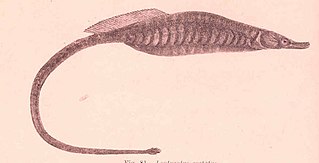
The school shark is a houndshark of the family Triakidae, and the only member of the genus Galeorhinus. Common names also include tope, tope shark, snapper shark, and soupfin shark. It is found worldwide in temperate seas at depths down to about 800 m (2,600 ft). It can grow to nearly 2 m long. It feeds both in midwater and near the seabed, and its reproduction is ovoviviparous. This shark is caught in fisheries for its flesh, its fins, and its liver, which has a very high vitamin A content. The IUCN has classified this species as critically endangered in its Red List of Threatened Species.

Riopa guentheri, commonly known as Günther's supple skink and Günther's writhing skink, is a species of lizard in the family Scincidae. The species is endemic to India.

The banded bellowsfish, banded yellowfish, banded snipefish, or bluebanded bellowsfish, is a species of fish of the family Macroramphosidae, found in southern oceans at depths of 35 to 1,000 m. Its length is up to 30 cm (12 in).

The crested bellowsfish or crested bellowfish, Notopogon lilliei, is a species of fish from the family Macroramphosidae. It is a demersal species which occurs over the continental shelf at depths of 80 to 600 m. They grow to lengths of up to 27 cm (11 in).

The crested bullhead shark is an uncommon species of bullhead shark, in the family Heterodontidae. It lives off the coast of eastern Australia from the coast to a depth of 93 m (305 ft). This shark can be distinguished from other members of its family by the large size of the ridges above its eyes and by its color pattern of large dark blotches. It typically attains a length of 1.2 m (3.9 ft).

The Australian angelshark is a species of angelshark, family Squatinidae, found in the subtropical waters of southern Australia from Western Australia to New South Wales between latitudes 18°S and 41°S, at depths down to 255 m (840 ft). Its length is up to 1.52 m (5 ft). Reproduction is ovoviviparous, with up to 20 pups in a litter.

Chromidotilapia guntheri, or Günther's mouthbrooder, is a cichlid from Africa. It was previously considered to consist of two subspecies, the common C. g. guntheri ranges from Liberia to Equatorial Guinea and Niger, and the critically endangered C. g. loennbergi which was thought to be restricted to Lake Barombi-ba-Kotto, a small crater lake in Cameroon but these subspecies are not supported by subsequent authorities. The species is noted for being a biparental mouthbrooder. Eggs are laid on a flat open surface and taken in the parents' mouth. Unlike many mouthbrooding cichlid species, both parents participate in the mouthbrooding.

Centropyge eibli, the blacktail angelfish, red stripe angelfish, orangelined angelfish, or Eibl dwarf angel is a species of marine ray-finned fish, a marine angelfish belonging to the family Pomacanthidae. It is found near reefs in the Indo-Pacific.

Cephalopholis miniata, also known as the coral grouper, coral hind, coral rock cod, coral cod, coral trout, round-tailed trout or vermillion seabass is a species of marine ray-finned fish, a grouper from the subfamily Epinephelinae which is in the family Serranidae which also includes the anthias and sea basses. It is associated with coral reefs and occurs in the Indo-Pacific.

Chaetodontoplus duboulayi, the scribbled angelfish, is a species of marine ray-finned fish, a marine angelfish belonging to the family Pomacanthidae. This species is from the southwestern Pacific Ocean.

Eumecichthys fiski, the unicorn crestfish or unicornfish, is a very rare, little-known species of crestfish in the family Lophotidae, and the only member of the genus Eumecichthys. It likely has a worldwide distribution, having been first discovered offshore of Kalk Bay, South Africa, and subsequently reported from the Sea of Japan, southwest Florida, Clarion Island off Mexico, Hawaii, and India. A report from the Bering Sea may have been in error. It is found in the bathypelagic zone, at a depth of around 1,000 m (3,300 ft).
Cepola pauciradiata, the Guinean bandfish, is a species of marine ray-finned fish belonging to the family Cepolidae, the bandfishes. It is found on the Atlantic coast of Africa.

Upeneichthys vlamingii, the blue-spotted goatfish, southern goatfish, black-striped goatfish, blue-striped red mullet, southern red mullet or western red mullet, is a species of marine ray-finned fish, a goatfish from the family Mullidae native to the coast of southern Australia.

Chaetodon guentheri, Günther's butterflyfish or the crochet butterflyfish, is a species of marine ray-finned fish, a butterflyfish belonging to the family Chaetodontidae. It is native to The western Pacific Ocean.

The deepbody pipefish is a species of pipefish endemic to Australia where it is only found along the southern coast. This species grows to a length of 12.9 centimetres (5.1 in) SL. This species is the only known member of the monotypic genus Kaupus which is named in honour of the ichthyologist Johann Jakob Kaup (1803-1873).

Pomadasys kaakan, the javelin grunter or barred javelin is a species of marine ray-finned fish, a grunt belonging to the family Haemulidae. It is native to the Indian and Pacific Oceans, from Africa to Australia.

Notolabrus gymnogenis, commonly known as the crimson banded wrasse, is a species of fish in the family Labridae. This colourful fish is endemic to Eastern Australia.
The crested oarfish is a species of crestfish in the family Lophotidae. It is an oceanodromous fish ranging from waters 0–92 meters deep, but may get stranded in shallow waters.

Pseudolabrus guentheri, or Gunther's wrasse, is a ray-finned fish from the wrasse family. It was named for Albert Günther.

Günther's grenadier is a species of deep-sea fish in the family Macrouridae.



















